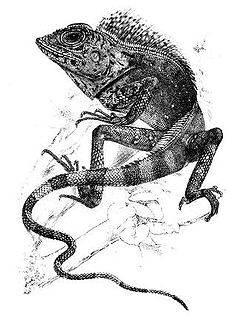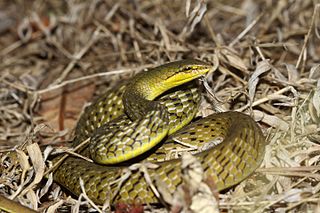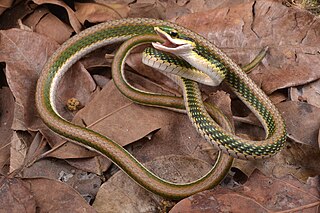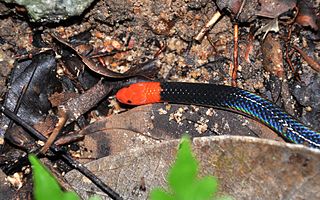
Gonocephalus is a genus of agamid lizards endemic to southeast Asia.

Ahaetulla perroteti, known commonly as the bronze-headed vine snake, Perrotet's vine snake, or the Western Ghats bronzeback, is a species of mildly venomous, rear-fanged snake in the family Colubridae. The species is endemic to the Western Ghats in South India.

Boiga forsteni, also known as Forsten's cat snake, is a species of mildly venomous rear-fanged colubrid endemic to South Asia.
Lycodon gammiei, commonly known as Gammie's wolf snake, is a species of nonvenomous colubrid endemic to northern India.

Dieurostus is a genus of snake in the family Homalopsidae. The genus Dieurostus is monotypic, containing only the species Dieurostus dussumieri, commonly known as Dussumier's water snake. The species, which is mildly venomous and rear-fanged, is endemic to Kerala, in southwestern India. It was formerly thought to be found in Bangladesh, although its distribution there is now disputed.

The rainbow water snake is a species of mildly venomous, rear-fanged, colubrid snake, endemic to Asia.

The rice paddy snake or plumbeous water snake is a species of mildly venomous, rear-fanged snake endemic to South Asia.

Spalerosophis diadema, known commonly as the diadem snake and the royal snake, is a species of large snake in the subfamily Colubrinae of the family Colubridae. The species is endemic to Asia and northern Africa.

Melanophidium wynaudense, commonly known as the Indian black earth snake, is a species of snake in the family Uropeltidae. The species is endemic to India.

Sphenomorphus dussumieri, commonly known as Dussumier's forest skink, is a species of skink, a lizard in the family Scincidae. The species is endemic to southern India.
Dromophis is a genus of colubrid snakes. There are two commonly accepted species in the genus Dromophis:

Plectrurus perrotetii, commonly known as the Nilgiri burrowing snake or Perrotet's shieldtail, is a species of harmless snake in the family Uropeltidae. The species is endemic to India.
The Chinese water snake, Chinese smooth water snake, Chinese mud snake or Chinese rice paddy snake is a species of mildly venomous, rear-fanged snake, endemic to Asia.

Leptophis mexicanus, commonly known as the Mexican parrot snake, is a species of medium-sized slender snake in the family Colubridae. The species is endemic to the Americas.

Ithycyphus miniatus is a species of venomous snake in the family Lamprophiidae. The species is native to Madagascar.

Calamaria schlegeli is a species of snake in the family Colubridae. The species is known commonly as the red-headed reed snake, white-headed reed snake, and pink-headed reed snake. It is native to Southeast Asia, where it occurs in Brunei, Indonesia, Malaysia, and Singapore.
Rabdion forsteni is a species of snake in the family Colubridae.

Lytorhynchus is a genus of snakes of the family Colubridae.

Uromacer catesbyi, also known as Catesby's pointed snake, is a species of snake in the family Colubridae.
Subsessor is a genus of snake in the family Homalopsidae. The genus is monotypic, containing the sole species Subsessor bocourti. The species is commonly known as Bocourt's mud snake or Bocourt's water snake and has traditionally been placed in the genus Enhydris.
















